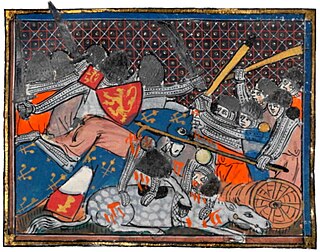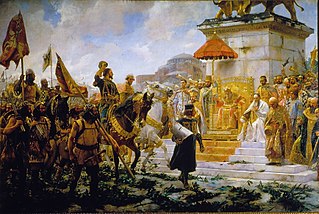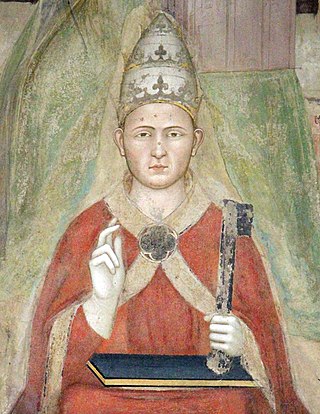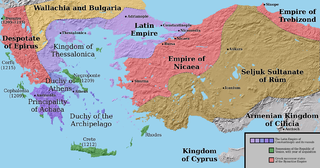
Year 1320 (MCCCXX) was a leap year starting on Tuesday of the Julian calendar.
The 1260s is the decade starting January 1, 1260 and ending December 31, 1269.
The 1270s is the decade starting January 1, 1270, and ending December 31, 1279.
The 1280s is the decade starting January 1, 1280 and ending December 31, 1289.
The 1290s was a decade of the Julian Calendar which began on January 1, 1290, and ended on December 31, 1299.

Year 1302 (MCCCII) was a common year starting on Monday of the Julian calendar.

Year 1303 (MCCCIII) was a common year starting on Tuesday of the Julian calendar.

Year 1305 (MCCCV) was a common year starting on Friday of the Julian calendar.

Year 1271 (MCCLXXI) was a common year starting on Thursday of the Julian calendar.

Year 1261 (MCCLXI) was a common year starting on Saturday of the Julian calendar.

Year 1263 (MCCLXIII) was a common year starting on Monday of the Julian calendar.

Year 1266 (MCCLXVI) was a common year starting on Friday of the Julian calendar.

Year 1279 A.D (MCCLXXIX) was a common year starting on Sunday of the Julian calendar.

Year 1281 (MCCLXXXI) was a common year starting on Wednesday of the Julian calendar.

Michael VIII Palaiologos or Palaeologus reigned as Byzantine emperor from 1261 until his death in 1282, and previously as the co-emperor of the Empire of Nicaea from 1259 to 1261. Michael VIII was the founder of the Palaiologan dynasty that would rule the Byzantine Empire until the Fall of Constantinople in 1453. He recovered Constantinople from the Latin Empire in 1261 and transformed the Empire of Nicaea into a restored Byzantine Empire. His reign saw considerable recovery of Byzantine power, including the enlargement of the Byzantine army and navy. It also included the reconstruction of the city of Constantinople, and the increase of its population. His re-establishment of the University of Constantinople contributed to the Palaeologan Renaissance, a cultural flowering between the 13th and 15th centuries.

The Eighth Crusade was the second Crusade launched by Louis IX of France, this one against the Hafsid dynasty in Tunisia in 1270. It is also known as the Crusade of Louis IX Against Tunis or the Second Crusade of Louis. The Crusade did not see any significant fighting as Louis died of dysentery shortly after arriving on the shores of Tunisia. The Treaty of Tunis was negotiated between the Crusaders and the Hafsids. No changes in territory occurred, though there were commercial and some political rights granted to the Christians. The Crusaders withdrew back to Europe soon after.

The Empire of Nicaea or the Nicene Empire was the largest of the three Byzantine Greek rump states founded by the aristocracy of the Byzantine Empire that fled when Constantinople was occupied by Western European and Venetian armed forces during the Fourth Crusade, a military event known as the Sack of Constantinople. Like the other Byzantine rump states that formed due to the 1204 fracturing of the empire, such as the Empire of Trebizond and the Despotate of Epirus, it was a continuation of the eastern half of the Roman Empire that survived well into the Middle Ages. A fourth state, known in historiography as the Latin Empire, was established by an army of Crusaders and the Republic of Venice after the capture of Constantinople and the surrounding environs.

Lord Edward's Crusade, sometimes called the Ninth Crusade, was a military expedition to the Holy Land under the command of Edward, Duke of Gascony in 1271–1272. In practice an extension of the Eighth Crusade, it was the last of the Crusades to reach the Holy Land before the fall of Acre in 1291 brought an end to the permanent crusader presence there.

Abaqa Khan, was the second Mongol ruler (Ilkhan) of the Ilkhanate. The son of Hulagu Khan and Lady Yesünčin and the grandson of Tolui, he reigned from 1265 to 1282 and was succeeded by his brother Ahmed Tekuder. Much of Abaqa's reign was consumed with civil wars in the Mongol Empire, such as those between the Ilkhanate and the northern khanate of the Golden Horde, and the Chagatai Khanate in Central Asia. Abaqa also engaged in unsuccessful attempts at invading Syria under the Mamluk Sultanate, which included the Second Battle of Homs.

A Byzantine-Mongol Alliance occurred during the end of the 13th and the beginning of the 14th century between the Byzantine Empire and the Mongol Empire. Byzantium attempted to maintain friendly relations with both the Golden Horde and the Ilkhanate realms, and was caught in the middle of growing conflict between the two. The alliance involved numerous exchanges of presents, military collaboration and marital links, but dissolved in the middle of the 14th century.
















